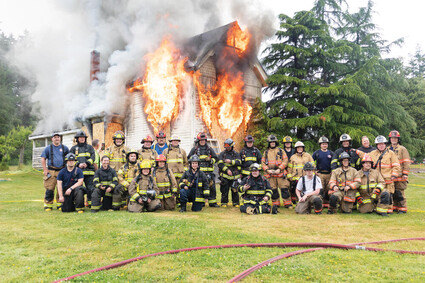Local fire departments burn house down on purpose
June 14, 2023

Ken Stern
PROUD OF THEIR WORK WELL DONE – Firefighters from Fire District 13, in black, Fire District 2, in brown, La Conner Fire Department, in brown, and the chief of Fire District 17, are in high spirits – and maybe feeling a little warm – after spending a day putting out fires they had set inside the Hedlund family house, behind them. They are not the least bit worried that now it is burning down. They set that fire. Do not try this at home.
Burning the Hedlund house to the ground Saturday was only the last straw and the least important fire of the day for the La Conner and Fire Districts 2, 13 and 17 fire departments. By the time the last of the piles of wood pallets were brought into the house and the last of the interior fires were started with a propane tank and torch at 1:15 p.m., the various firefighting crews had spent hours in every room of the two story structure, examining, fighting, putting out and being tested on a variety of room, wall, floor and ceiling fire scenarios.
The June 11 training was the third day of controlled burns at the house, donated by the Hedlund family. Patriarch Chuck Hedlund was a long time Fire District 13 commissioner until his death in 2019.
By Saturday some rooms had been repeatedly prepped, charred and burned for and from the earlier trainings. This day staffs from the four departments, as independent teams and integrated groups, finished the job. Throughout the morning the practices increased in scope, with pallets to be burned brought into individual rooms.
Windows had been removed and the openings covered with plywood modified with hinges and handles. Manipulating these shutters adjusted air flow, a critical factor in fire intensity.
Each room had three to five burn events, said La Conner Fire Chief Aaron Reinstra. "The first one was pretty exciting then we dialed it down." Several of his firefighters, and those from other departments, were getting their first exposure in this live fire training. "Live fire training is always one of the hardest things to get," he noted.
FD 13 Fire Chief Wood Weiss stressed the importance of the day "so the first time you get to see a live fire it is not a large fire. Getting to practice on a real house is beneficial." He called it "a real special moment."
Fittingly, it was FD 13 staff who spent months preparing for the day. La Conner Fire Chief Aaron Reinstra praised his colleagues: "Fire District 13 has been amazing to get everyone together for this event."
Weiss recognized his staff: Live fire training officer Duane Dent for planning and executing a well-run. safe and informative burn; training officer Captain Olbu for running water supply; Battalion Chief Jurdi for saving the trees right next to the house with a dedicated hose stream,;and for all our instructors who worked so hard to make this house burn a total success.
John Tanaka, a retired captain formerly with the City of Everett Fire Protection and a former FD 13 assistant fire chief, was the technical advisor.
Thirty people from four departments participated: 12 from FD 13; La Conner, seven; Fire District 2, McLean Road, 10; and the Guemes Island fire chief, FD 17.
The support crew, which managed the food tent, was led by Chris Weiss cooking hot dogs and dishing out baked beans.
Reinstra, Weiss and Stephanie Banaszak, a La Conner Firefighter Association member chronicling the day, emphasized the cross-department work and communications aspects, Banaszak noting the interesting social dynamics, that between exercises intra-department groups formed.
Reinstra explained, "The nice thing about these trainings is we integrate with each other. We use the same terminology. You can plug anyone into with each other and it goes just the same."
Throughout the morning small groups went in and out of the house and worked various hose lines connected to tender trucks. There was a 3,000 gallon portable pool filled with water. Firefighters with air tanks on their backs were rocking and swaying slightly to minimize the chirping and tweets from sensors detecting people not in motion.
When the house was set on fire at 1:15 p.m., the training was done. The departments took group photos and spent the next hour walking around. The grass, trees, outbuildings and fencing to the west were continuously hosed down against the heat and so were department vehicles on Dodge Valley Road. By 2 p.m. the heat was noticeable to those standing on the road.
Banasczk reported the fire took over five hours to die down. She posted "By the day's end, all house beams fell in anticipated directions, and as if for posterity, one (of two) chimneys remained upright resembling a totem pole."










Reader Comments(0)